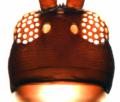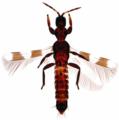Aeolothrips duvali
Recognition data
Distinguishing features
Both sexes with complete, banded wings; median pale band shorter than distal dark band. Body and legs brown, antennal segment III brown, with basal third brownish yellow. Head and pronotum with no long setae. Fore tarsus apically with stout recurved ventral hamus. Antennae 9-segmented, segment III long with linear sensorium about 0.3 as long as segment, IV with sensorium almost 0.5 as long as segment and curved distally; segments V–IX forming a single unit with V slightly shorter than VI–IX. Marginal setae on sternites arising at or close to margin; sternite VII supernumerary paired setae arising well in front of margin. Male tergites IV and V sometimes with very small paired dorsal tubercles; setae at base of bifurcate claspers on tergite IX almost as long as clasper, with no stout curved seta lateral to clasper.
Related and similar species
A. duvali is a member of the A. fasciatus group but has antennal segment III more extensively brown, and the seta at the base of the claspers in males is shorter. Just over 90 species are placed currently in the genus Aeolothrips, of which more than 50 are from the Palaearctic Region (mainly Europe), and 28 from the Nearctic (mainly western USA). Only two species are recorded from the Neotropics; the one from Chile is probably the same as A. fasciatus, and one from Panama is probably not a member of this genus (Mound & Marullo, 1996).
Taxonomic data
Current valid name
Aeolothrips duvali Moulton
Original name and synonyms
- Aeolothrips duvali Moulton, 1927: 186
Family placement
Aeolothripidae
Biological data
Life history
Presumably a facultative predator in flowers, with a mixed diet of pollen and the larvae of other thrips.
Host plants
Swept from a range of wild plants, particularly flowers of Mimulus aurantiacus (Scrophulariaceae), but with no information on any specificity for breeding.
Tospoviruses vectored
None
Crop damage
None
Distribution data
Area of origin
Western USA
Distribution
Described from Texas, this species is recorded from California, Arizona, Nevada, New Mexico, Colorado, Utah, Arkansas, Wyoming, Oklahoma and Mexico.







